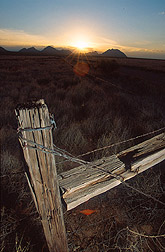This page has been archived and is being provided for reference purposes only. The page is no longer being updated, and therefore, links on the page may be invalid.
Literature Review Predicts Carbon Storage on Rangeland
By Rosalie Marion BlissJuly 31, 2007
A literature review of various land management practices and their long-term effects on rangeland's ability to capture carbon from the atmosphere and store it in soil has been conducted by Agricultural Research Service (ARS) scientists. Over a 30-year period, for example, restoring permanent vegetation on mining lands was found to increase soil organic carbon by about 400 percent.
ARS rangeland scientist Justin Derner and retired soil scientist Gerald E. Schuman published the review in the Journal of Soil and Water Conservation. They are with the ARS High Plains Grasslands Research Station in Cheyenne, Wyo. ARS is the U.S. Department of Agriculture's chief scientific research agency.
Carbon dioxide (CO2) is a major greenhouse gas emitted into the Earth's atmosphere, primarily due to burning of fossil fuels. These emissions are contributing to global climate change. Rangeland and farmland can act as an organic carbon soil sink. In this process, CO2 from the atmosphere is captured by plant photosynthesis and trapped in the soil, which helps mitigate the warming, or greenhouse, effect.
The review provides information on the rate of this process, called carbon sequestration, occurring on rangelands under various precipitation conditions and management practices. The review also sheds light on best management practices that, when implemented on rangelands, offset atmospheric carbon emissions and may earn agricultural producers and land owners "carbon credits."
Carbon credits are purchased, for example, by businesses that must either reduce emissions or buy offsetting credits. Future government policies may require limits on the amount of greenhouse gases that are emitted by U.S. industries and increase the value of carbon credits among trade markets in the United States and abroad. The researchers used the data to develop equations that help predict the amount of carbon expected to be sequestered on large or grouped tracts of rangeland.
In addition to enhancing carbon sequestration, best management practices were also found to provide other benefits to the ecosystem, such as improved water-holding capacity, soil structure and nutrient cycling.

